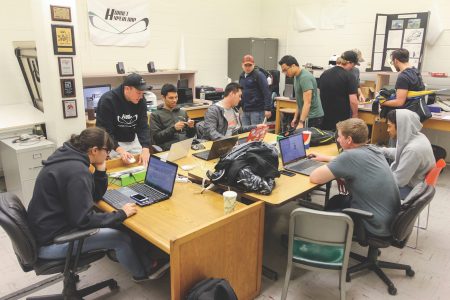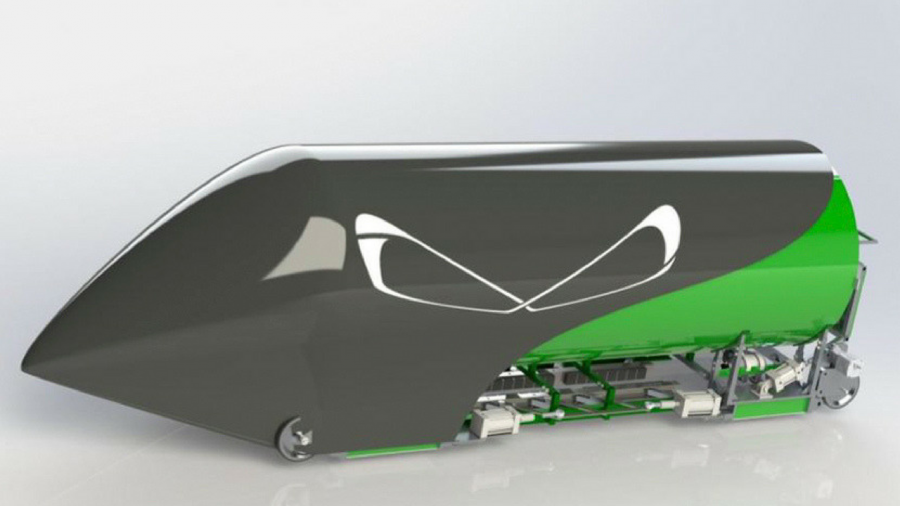In 2013, Tesla and SpaceX founder Elon Musk announced his concept for the Hyperloop and the world could not wait to see what he would build.
But Musk decided to pitch the building of his transportation proposal to anyone brave enough to try — and Sacramento State is one of hundreds of schools and technology companies to take up the challenge.
The concept of Hyperloop is to have a pod capable of carrying people or cargo levitating through an almost airless tube faster than the speed of sound, allowing a travel time of around 30 minutes from San Francisco to Los Angeles.
This summer Space-X will be holding its second Hyperloop competition in Hawthorne, California. The first competition was in January, and the Michigan Institute of Technology and Delft University of Technology ended up the winning schools.
The Hornet Hyperloop team found out this semester that it had made it into the final 24 teams, placing them with the top engineering schools in the world and one of three teams from California to compete.
Team members said they are honored to compete among the greatest engineering schools in the world and for a project that may change the world of transportation forever.
“It’s pretty much the best engineering schools in the world and the fact that Sac State has made it that far — it shows that our engineering department and knowledge here at Sac State is on par with some of those big schools,” said lead engineer Dylan Cracraft.
Team captain and mechanical engineering senior Paul Orozco started Hornet Hyperloop in 2016 and struggled to get a solid team around him. It wasn’t until last summer that he was able to get a team together from disciplines to bring this pod to life.
“This is a new club,” Orozco said. “There really hasn’t been any ground set as to how to do and what to do, and one of the things I like is the interdisciplinary relationship between courses.”
Hornet Hyperloop is building a scaled-downed pod that will only take a year to build from the ground up and will operate around 200mph.

However, it will still use the same principals of the propulsion system, aerodynamic principles and environment as the full-scale model, as the team has built its pod to be easily scaleable to fullsize without changing much of the structure.
“A lot of our systems are pretty scaleable,” Orozco said. “Our overall structure is just kind of lengthened and widened a little bit, because it’s based off a normal airplane structure, so that also means that construction cost is a little cheaper because you don’t have to train people you can just grab people from the aerospace industry.”
Most of the materials used on the pod are different types of aluminium. Stainless steel is used on the joints as it is not as magnetic and less likely to rip away from the pod because of the high energy of the magnets.
The movement of the pod is not the same as a conventional train with wheels and tracks. It is actually levitating by the force between the magnets on the pod and the magnets on the floor of the tube to reduce drag and friction.
The blistering speed of the pod is achieved by using the kinetic energy of the magnets to push the pod along, as a compressor at the front of the pod sucks in the air that forms around the front of the pod from the high speed and pushes it out the back of the pod for propulsion and the bottom of the pod to assist with levitation.
Working technology like this in a way never done before, some serious problem-solving has been required, but Cracraft said that the challenge is what the team thrives off of.
“The main thing is that you are working on something that has never been done before and being able to be super creative and coming up with your own ideas on how to solve things,” Cracraft said.
Cracraft, a senior in majoring mechanical engineering, has leadership experience from working at Hewlett-Packard Co. and has an internship with Aerojet in the summer to help design rockets.
“The Hyperloop has helped me to learn how to take a concept and an idea and turn it into an actual final design,” he said. “As far as going forward I want to be in the aerospace industry so working on a project like this is definitely helpful in that.”
Funding a project like this has not been easy, with an estimated cost of $55,000 or more for testing, materials, building and transportation to the competition.
“So far a lot of funding has been through the school, but right now we are reaching out to companies,” Orozco said. “This morning I was on a phone call with a company in Italy. We’re just trying to reach out and get either monetary or material sponsorships from various companies.”
Business lead and senior Kevin Nguyen came on knowing that the team needed more help on the business side and has since been recruiting more students and searching for sponsors.
Nguyen is focusing on Sacramento-based companies that have designated departments for sponsorships by sending proposals and sometimes speaking with companies and organizations on the phone, even if they aren’t in the tech industry, such as Golden 1, the Sacramento Kings and Sacramento Republic FC.
As Sac State is the only Northern California team competing, he is hopeful that companies in the Bay Area will be more inclined to help as well.
Nguyen has learned that patience is a virtue while looking for sponsors and expects more intensity now that the team has been placed in the finals and will need materials to build the pod.
“Companies have to have some interest in us,” Nguyen said. “It’s like pitching an investment — there has to be a return for them.”
Those returns include space for the company’s logo on the pod and a walk around the factory.
A completed physical model is expected to be finished this August in time for the competition. Until then the team will continue to test, build and find funding for the project.
































































































































P. Hamil • Apr 19, 2017 at 9:06 pm
Where is the air intake? Is the pointy-end the back to reduce drag, and the front is flat for fan/compressor intake? Please show pic oriented the other way.